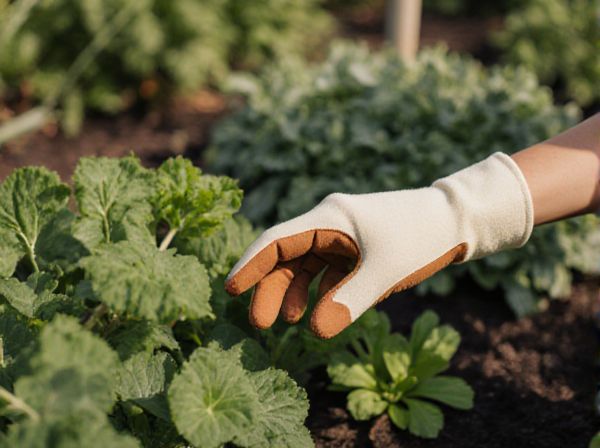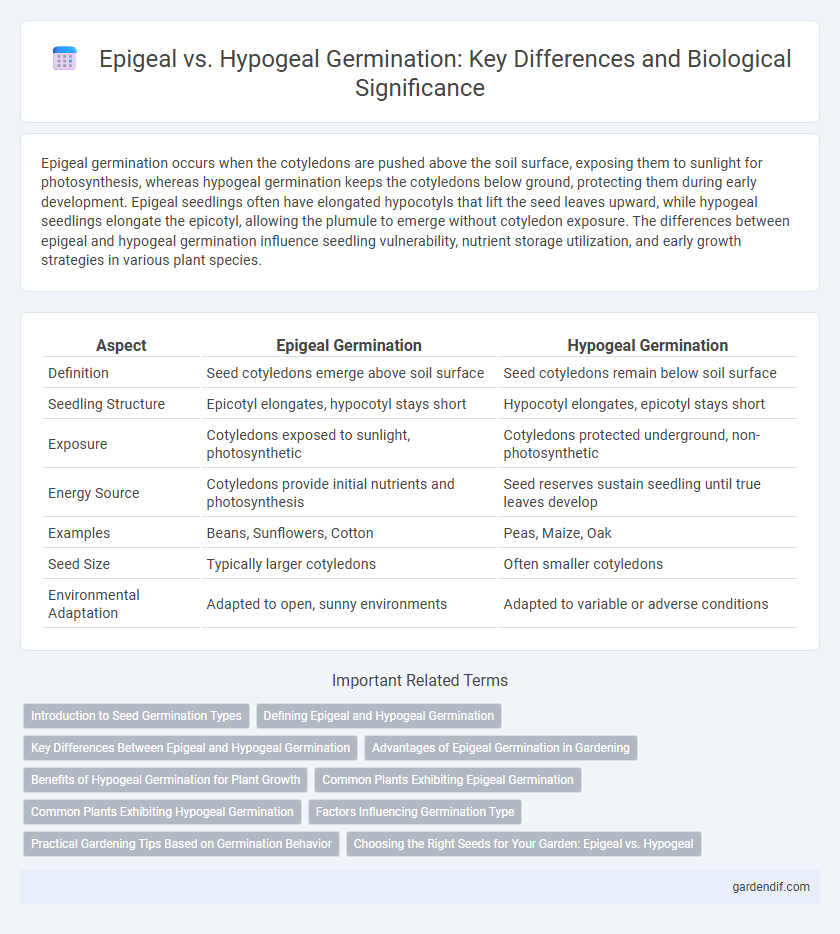
Epigeal vs Hypogeal Illustration
Epigeal germination occurs when the cotyledons are pushed above the soil surface, exposing them to sunlight for photosynthesis, whereas hypogeal germination keeps the cotyledons below ground, protecting them during early development. Epigeal seedlings often have elongated hypocotyls that lift the seed leaves upward, while hypogeal seedlings elongate the epicotyl, allowing the plumule to emerge without cotyledon exposure. The differences between epigeal and hypogeal germination influence seedling vulnerability, nutrient storage utilization, and early growth strategies in various plant species.
Table of Comparison
| Aspect | Epigeal Germination | Hypogeal Germination |
|---|---|---|
| Definition | Seed cotyledons emerge above soil surface | Seed cotyledons remain below soil surface |
| Seedling Structure | Epicotyl elongates, hypocotyl stays short | Hypocotyl elongates, epicotyl stays short |
| Exposure | Cotyledons exposed to sunlight, photosynthetic | Cotyledons protected underground, non-photosynthetic |
| Energy Source | Cotyledons provide initial nutrients and photosynthesis | Seed reserves sustain seedling until true leaves develop |
| Examples | Beans, Sunflowers, Cotton | Peas, Maize, Oak |
| Seed Size | Typically larger cotyledons | Often smaller cotyledons |
| Environmental Adaptation | Adapted to open, sunny environments | Adapted to variable or adverse conditions |
Introduction to Seed Germination Types
Epigeal and hypogeal germination represent the two primary types of seed germination distinguished by cotyledon behavior during seedling emergence. In epigeal germination, cotyledons are pushed above the soil surface, becoming photosynthetic, whereas in hypogeal germination, cotyledons remain below ground, serving as nutrient storage. Understanding these mechanisms aids in optimizing agricultural practices and seedling management for various crop species.
Defining Epigeal and Hypogeal Germination
Epigeal germination occurs when the seed cotyledons are pushed above the soil surface during sprouting, exposing them to sunlight and enabling early photosynthesis. Hypogeal germination, in contrast, keeps the cotyledons below ground, relying on the seed's stored nutrients while the shoot emerges from the soil. These distinct germination types influence the seedling's vulnerability and growth strategy, affecting plant establishment.
Key Differences Between Epigeal and Hypogeal Germination
Epigeal germination involves the cotyledons emerging above the soil surface, exposing them to light and aiding photosynthesis, while hypogeal germination keeps cotyledons below ground, protecting them from harsh environmental conditions. In epigeal germination, the hypocotyl elongates to push cotyledons upwards, whereas in hypogeal germination, the epicotyl grows, lifting the plumule above the soil with cotyledons remaining underground. These differences impact seedling vulnerability, growth rate, and adaptation strategies, with epigeal seedlings often developing faster but being more susceptible to damage compared to hypogeal seedlings.
Advantages of Epigeal Germination in Gardening
Epigeal germination offers several advantages in gardening, including faster seedling emergence and improved photosynthesis since cotyledons are elevated above the soil, enhancing light capture. This type of germination also allows for quicker detection of seedling health, facilitating early intervention against pests or diseases. Moreover, epigeal seedlings often establish stronger root systems rapidly, promoting robust growth in various soil conditions.
Benefits of Hypogeal Germination for Plant Growth
Hypogeal germination protects the cotyledons beneath the soil surface, reducing exposure to herbivores and environmental stress such as frost or drought. This underground protection supports steady nutrient supply and water absorption during early plant development, promoting stronger root establishment. Consequently, plants with hypogeal germination often demonstrate enhanced resilience and improved growth performance in variable conditions.
Common Plants Exhibiting Epigeal Germination
Common plants exhibiting epigeal germination include beans, sunflowers, and cucumbers, where the cotyledons are pushed above the soil surface during germination. This process involves the elongation of the hypocotyl, lifting the seed leaves into the air for photosynthesis. Epigeal germination is characterized by rapid early growth and is typical in many dicotyledonous species.
Common Plants Exhibiting Hypogeal Germination
Hypogeal germination is characterized by the cotyledons remaining below the soil surface while the epicotyl elongates and emerges above ground. Common plants exhibiting hypogeal germination include peas (Pisum sativum), maize (Zea mays), and sunflower (Helianthus annuus), where the nutrient-rich seed reserves remain protected underground. This germination type enhances seedling survival by shielding cotyledons from environmental stressors and herbivory.
Factors Influencing Germination Type
Temperature, light exposure, and soil moisture critically influence whether germination follows an epigeal or hypogeal pattern. Seed morphology, including seed coat thickness and nutrient reserves, directly impacts the energy available for the seedling's shoot or root emergence above or below ground. Environmental stressors such as soil depth and oxygen availability further determine the germination type by affecting embryo development and cotyledon positioning.
Practical Gardening Tips Based on Germination Behavior
Epigeal germination, where the cotyledons emerge above the soil surface, benefits from loose, well-draining soil and regular light exposure to encourage strong seedling growth. Hypogeal germination, with cotyledons remaining underground, requires careful soil moisture management and protection from deep tilling to prevent stem damage. Understanding these germination behaviors guides gardeners in seed planting depth and post-germination care, enhancing successful crop establishment.
Choosing the Right Seeds for Your Garden: Epigeal vs. Hypogeal
Choosing the right seeds for your garden involves understanding the differences between epigeal and hypogeal germination. Epigeal seeds, such as beans and sunflowers, push their cotyledons above the soil surface, promoting faster early growth but requiring more moisture and warmth. Hypogeal seeds, like peas and corn, keep cotyledons underground, offering better protection against cold and drought, making them ideal for cooler climates or variable conditions.
Epigeal vs Hypogeal Infographic

 gardendif.com
gardendif.com